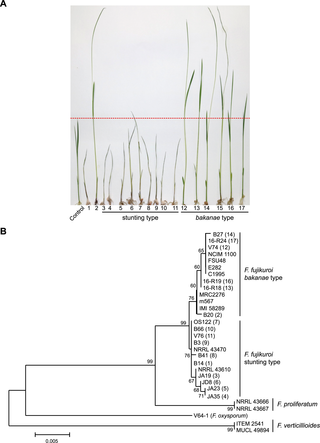PLoS Pathogens ( IF 5.5 ) Pub Date : 2017-10-26 , DOI: 10.1371/journal.ppat.1006670 Eva-Maria Niehaus , Hee-Kyoung Kim , Martin Münsterkötter , Slavica Janevska , Birgit Arndt , Svetlana A. Kalinina , Petra M. Houterman , Il-Pyung Ahn , Ilaria Alberti , Stefano Tonti , Da-Woon Kim , Christian M. K. Sieber , Hans-Ulrich Humpf , Sung-Hwan Yun , Ulrich Güldener , Bettina Tudzynski

|
Fusarium fujikuroi causes bakanae (“foolish seedling”) disease of rice which is characterized by hyper-elongation of seedlings resulting from production of gibberellic acids (GAs) by the fungus. This plant pathogen is also known for production of harmful mycotoxins, such as fusarins, fusaric acid, apicidin F and beauvericin. Recently, we generated the first de novo genome sequence of F. fujikuroi strain IMI 58289 combined with extensive transcriptional, epigenetic, proteomic and chemical product analyses. GA production was shown to provide a selective advantage during infection of the preferred host plant rice. Here, we provide genome sequences of eight additional F. fujikuroi isolates from distant geographic regions. The isolates differ in the size of chromosomes, most likely due to variability of subtelomeric regions, the type of asexual spores (microconidia and/or macroconidia), and the number and expression of secondary metabolite gene clusters. Whilst most of the isolates caused the typical bakanae symptoms, one isolate, B14, caused stunting and early withering of infected seedlings. In contrast to the other isolates, B14 produced no GAs but high amounts of fumonisins during infection on rice. Furthermore, it differed from the other isolates by the presence of three additional polyketide synthase (PKS) genes (PKS40, PKS43, PKS51) and the absence of the F. fujikuroi-specific apicidin F (NRPS31) gene cluster. Analysis of additional field isolates confirmed the strong correlation between the pathotype (bakanae or stunting/withering), and the ability to produce either GAs or fumonisins. Deletion of the fumonisin and fusaric acid-specific PKS genes in B14 reduced the stunting/withering symptoms, whereas deletion of the PKS51 gene resulted in elevated symptom development. Phylogenetic analyses revealed two subclades of F. fujikuroi strains according to their pathotype and secondary metabolite profiles.
中文翻译:

地理上较远的镰刀菌镰刀菌分离株的比较基因组学揭示了与次级代谢产物谱相关的两种不同的病理类型
富士镰刀菌引起水稻的巴卡那病(“愚蠢的幼苗”),其特征是真菌产生的赤霉素(GAs)导致幼苗的过度伸长。这种植物病原体还因产生有害的霉菌毒素而闻名,例如镰刀菌素,岩藻酸,阿皮菌素F和金霉素。最近,我们产生了F的第一个从头基因组序列。富士黑氏菌株IMI 58289与广泛的转录,表观遗传,蛋白质组学和化学产物分析相结合。在优选的宿主植物水稻的感染期间,GA的生产显示出提供了选择性的优势。在这里,我们提供了另外8个F的基因组序列。富士黑井与遥远的地理区域隔离。分离株的染色体大小不同,很可能是由于亚端粒区域的可变性,无性孢子的类型(微分生孢子和/或大分生孢子)以及次生代谢物基因簇的数量和表达。尽管大多数分离株引起典型的巴卡那病症状,但一种分离株B14却导致被感染幼苗的发育迟缓和早期枯萎。与其他分离株相比,B14在水稻感染期间没有产生GA,但产生了大量的伏马毒素。此外,从其它菌株通过的三个附加聚酮化合物合酶(PKS)的基因(存在不同PKS40,PKS43,PKS51)和不存在的˚F。富士黑鸟特有的Apicidin F(NRPS31)基因簇。对其他野外分离株的分析证实,病理型(巴卡那病或发育迟缓/枯萎)与产生GA或伏马菌素的能力之间具有很强的相关性。B14中伏马毒素和富马酸特异性PKS基因的缺失减少了发育迟缓/枯萎症状,而PKS51基因的缺失导致症状发展升高。系统发育分析显示F的两个子分支。根据其病原体类型和次生代谢产物谱,对藤久郎伊菌株进行了鉴定。











































 京公网安备 11010802027423号
京公网安备 11010802027423号